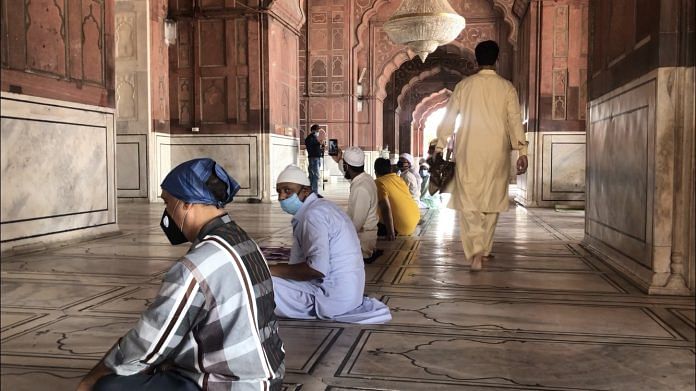New Delhi: Young Muslims “stand somewhat apart” from their Hindu, Sikh, and Christian cohorts as they are the only community to have recorded a significant decline in religious activities over the last five years, according to a survey report released earlier this month.
The report, titled ‘Indian Youth: Aspirations and Vision for the Future’, was based on a survey conducted in July-August this year on 6,277 people aged 18-34 across 18 states. The study was carried out by the Centre for the Study of Developing Societies (CSDS) under its research programme Lokniti, in collaboration with German think tank Konrad Adenauer Stiftung (KAS).
The survey found that the proportion of Muslims praying, fasting, visiting mosques, and reading or watching religious material was lower than it was in 2016, when the last CSDS-Lokniti survey was conducted.
Muslims also stood apart from other communities in another respect: their experience of being discriminated against by their friends because of religion. While two other religious minorities, Christians and Sikhs, were similar to Muslims in expressing a “strong sense of despair” about communal harmony in India, a much lower proportion of them reported experiencing religious discrimination.
Also Read: 82% Sikh youth pray frequently, highly religious compared to others, shows CSDS-Lokniti survey
Muslims went from highest to lowest in religious activity in 5-yr span
The 2016 CSDS youth survey, conducted on a sample size of 5,681, found that Muslim youths reported higher religiosity than any other group. In that year, 97 per cent of Muslim respondents said they prayed regularly, followed by Hindus (92 per cent), Sikhs (92 per cent), and Christians (91 per cent).
However, in 2021, only 86 per cent of Muslim youth said they prayed regularly — a decline of 11 percentage points from five years ago. In comparison, the share of youth who report praying regularly has risen among Sikhs (96 per cent) and Christians (93 per cent), and declined only marginally for Hindus (88 per cent).
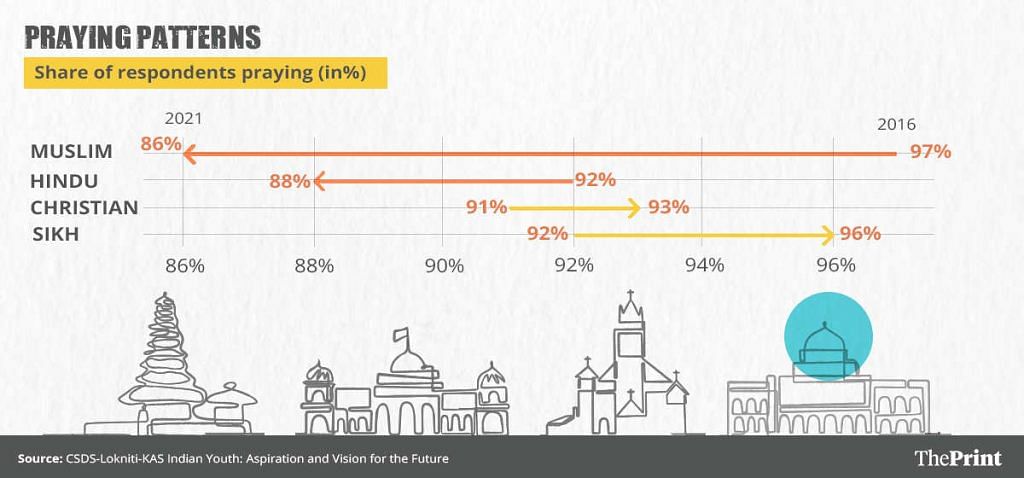
Similarly, there has been a sharp decline in the proportion of Muslim youths visiting places of worship.
In 2016, 85 per cent of Muslim respondents reported that they visited their place of worship (at various frequencies), but in 2021, only 79 per cent said they had done so. While there was a decline among other religions too, it was the highest among Muslims — 6 percentage points, followed by 4 percentage points for Hindus (to 88 per cent from 92), 2 percentage points for Christians (to 89 per cent from 91), and 1 percentage point for Sikhs (to 96 per cent from 97).
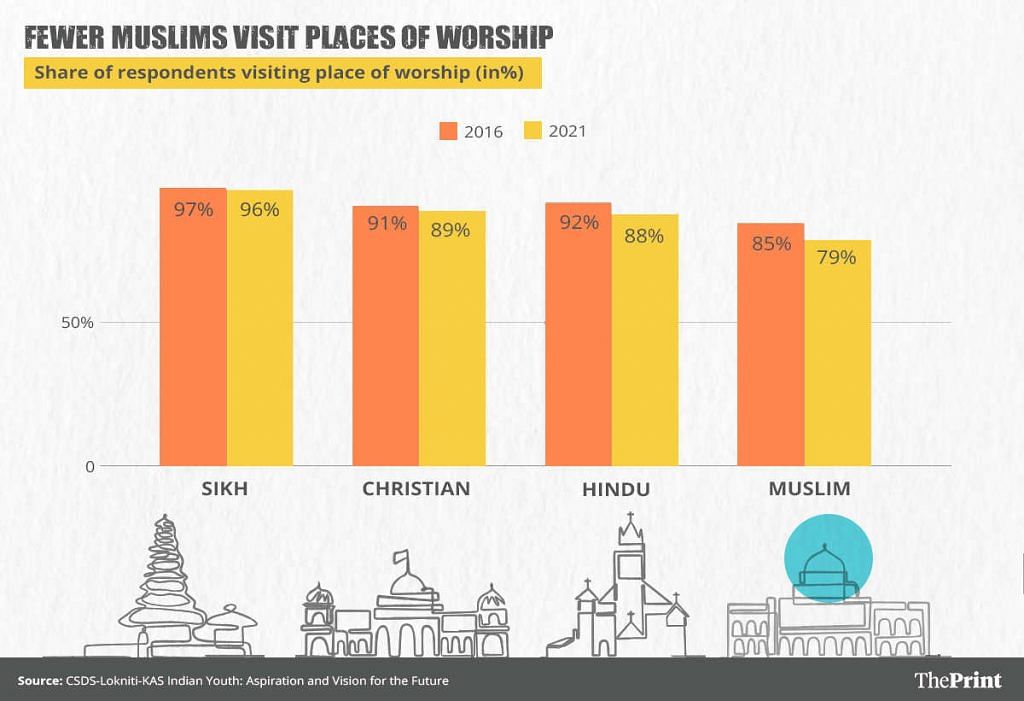
Self-perception of religious participation
Overall, 19 per cent of respondents said their religious participation had witnessed an increase, while 17 per cent said it had declined, 57 per cent said it had stayed the same, and 7 per cent did not give a response.
Here too, a greater share of Muslims than other religions reported a net decline in their perception of their religious participation.
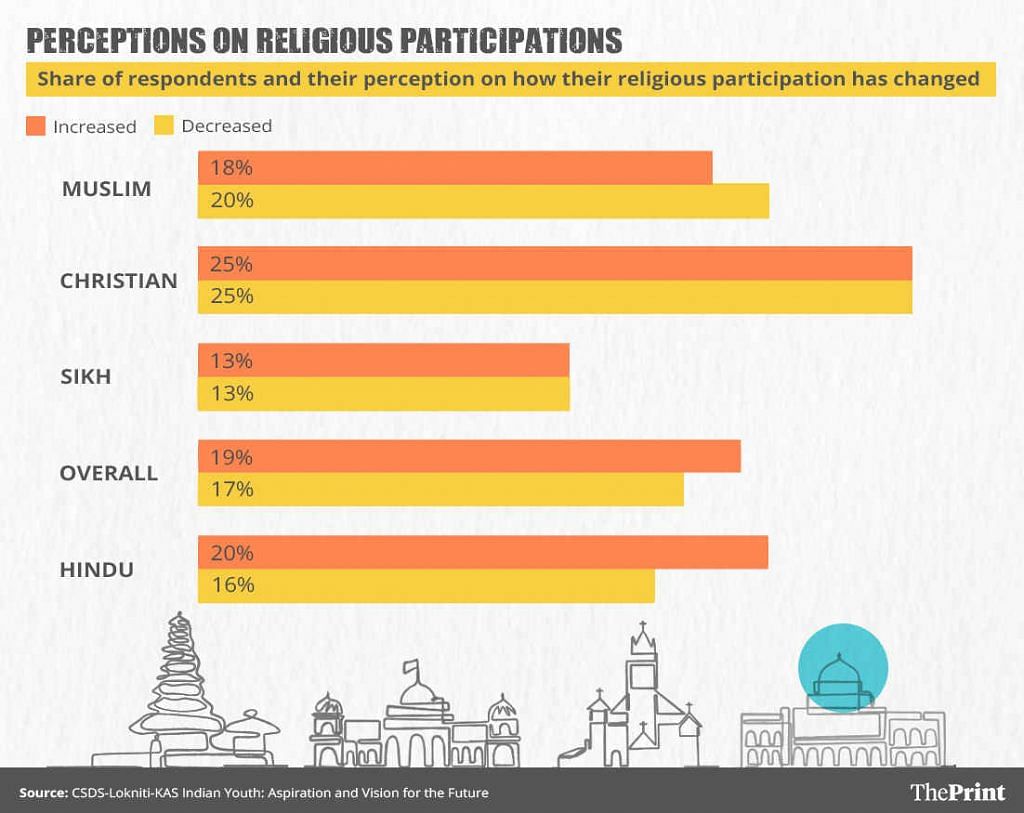
While 18 per cent of Muslim youngsters observed an increase in their religious participation, 20 per cent felt that their religious participation had gone down.
For Christians and Sikhs, the share of respondents observing both an increase and decrease was the same, at 25 per cent and 13 per cent, respectively.
Hindus reported a net increase in their perception of their religious participation. About 20 per cent of Hindu respondents reported a rise in religious participation, while 16 per cent observed a fall.
Pessimism about religious harmony in India
The CSDS report took note of data from the National Crime Records Bureau, pointing out that 857 cases of communal/religious rioting were registered in 2020, nearly doubling from 438 in 2019.
The report also mentioned recent “hate crimes and lynchings” targeting minority communities as well as the new citizenship law for religious minorities from India’s three Muslim-majority neighbours. In this context, the survey asked the respondents whether they thought religious harmony would improve or worsen in the next five years.
While only 19 per cent of Hindus said they believed there would be a deterioration in communal harmony, the minorities were far more pessimistic — 31 per cent of Christians and 33 per cent each of Muslims and Sikhs said they believed religious amity would decline.
The report’s authors dug deeper into the views of Muslim youth on the grounds that the community has “borne the brunt of discrimination and violence in recent years”.
According to the report, the “despair” about religious co-existence was higher among the Muslims who lived in states with a Muslim population higher than the national average of 14.23 per cent. Taken together, these states — Assam, West Bengal, UP, Bihar, Jharkhand, and Kerala — were more likely to be pessimistic about religious harmony.
In these states collectively, 35 per cent of Muslims said they expected a deterioration compared with 23 per cent in states with a lower-than-average Muslim population.
The survey further found that Muslims in states which had a higher-than-average Muslim population were also more likely to report religious discrimination, arguably because there was “a greater chance of interaction” between the majority and minority communities.
Perception of religious discrimination
According to the 2011 Census, Hindus comprise about 80 per cent of the population, followed by the three biggest minority communities — Muslims (14.23 per cent), Christians (2.3 per cent), and Sikhs (1.72 per cent).
Among the minorities sampled in the survey, Muslims reported experiencing discrimination from their friends most frequently.
About 44 per cent of Muslim respondents said they faced discrimination from their friends, with 13 per cent saying this happened often and 31 per cent saying it occurred sometimes. Only 18 per cent Christians (4 per cent often, 14 per cent sometimes) and 8 per cent Sikhs (3 per cent often, 5 per cent sometimes) reported such discrimination, the survey data showed.
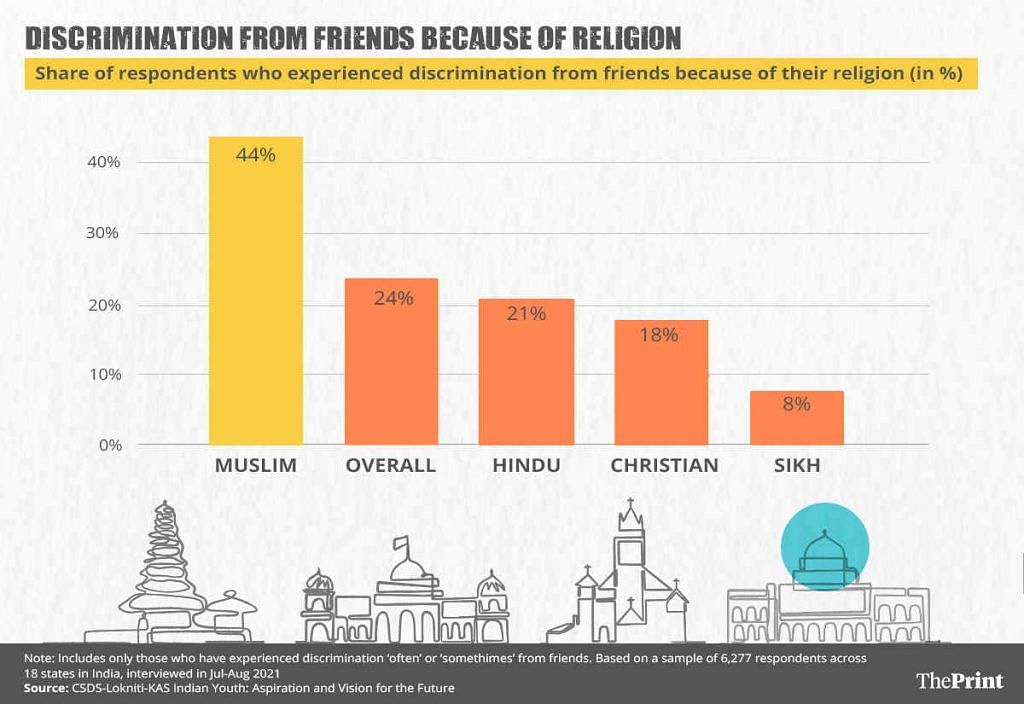
While, on average, 70 per cent of the respondents said they never faced discrimination for their religion, this was only 49 per cent for Muslims.
“What is interesting here is that unlike on the issue of religious harmony where there was some sort of unanimity of opinion among youths from different religious minorities, on the issue of facing discrimination, Muslims were quite alone in feeling so,” the report said.
Are Muslims really getting less religious?
The survey report in its discussion of the results said it seemed “counter-intuitive” that Muslim youth appeared to be less religious than before.
“One would think that being at the receiving end of hate, discrimination, and violence would have resulted in an even greater proportion of Muslims turning towards their faith,” the report said, adding that it was possible that some Muslim respondents may have felt “less comfortable” about revealing their religious practices.
ThePrint spoke to Islamic scholars for their views on the findings of the study, and found that they were generally sceptical.
According to Khalid Firangi Mahali, chairman of the Lucknow-based Islamic Centre of India, the survey’s data do not reflect ground realities.
“These kinds of surveys are done on very few people, mostly in urban areas. They do not represent the entire population. I don’t believe that there is any decline in Muslim youngsters’ religious participation,” Mahali said. “You go to any mosque in this country on a Friday and see the demographics by yourself. You will find lots of young men coming for the prayers.”
Hilal Ahmed, a scholar of political Islam and associate professor at CSDS, told ThePrint that it is also important to keep in mind that how people perceive their religious practice is subjective.
“The survey data is based on the perception of an individual… and religiosity has a high degree of subjectivity. For one person, offering namaz every Friday might be considered as a deviation from the established norm of being a practising Muslim. A person who offers it five times a day might consider themselves as a regular praying person,” he told ThePrint.
Ahmed also pointed out that Muslims tend to be more private about religion, and cited an article he wrote for ThePrint around the same issue.
“It could be argued that Islamic religiosities do not entirely determine the everyday life of Indian Muslim communities. That is the reason why they describe themselves as somewhat religious,” Ahmed had written in the piece.
So why does data show a decline?
According to Ahmed, there is a decline of established forms of religiosity in India. For example, Tablighi Jamaat, which for several decades was an important Sunni Muslim movement promoting greater religiosity, is no longer as attractive to young Muslims for expressing their Islam. “This has resulted in a creation of a vacuum, due to which Muslims are looking for a new religiosity,” Ahmed said.
He added that Muslim youths may not be praying as often but many are doing other things like visiting babas and peers for consultation. “Muslims these days are in a need of new religiosity — they have not moved away from religion, rather they are seeking a new path,” he said.
(Edited by Asavari Singh)
Also Read: India can’t alienate its 20 crore Muslims, not when Taliban are finding legitimacy, not ever


